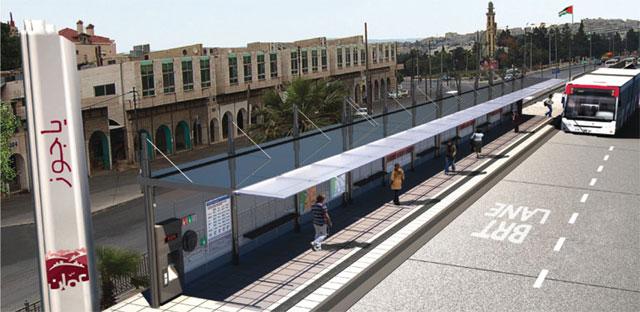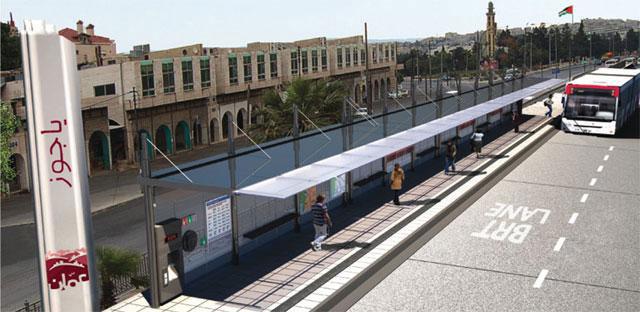You are here
GAM ‘understands’ scepticism over BRT, promises delivery, full access for all
By Camille Dupire - Jan 24,2018 - Last updated at Jan 24,2018
AMMAN — The Bus Rapid Transit (BRT) project currently under construction in Amman will be "accessible to all, whatever their social, financial or cultural status is" and the access to the buses will be "facilitated for the most vulnerable groups of society", officials have said.
In response to people’s scepticism over the municipality’s ability to complete the project, which had been halted for years, one senior official said doubts are understandable, vowing that the project would be operational on time and all people would be ensured access to the service.
The remarks came following a recent visit by French experts from the Paris Municipality to Amman that aimed to provide support and expertise to the Greater Amman Municipality (GAM) personnel in the implementation of the project.
A long-awaited improvement
"Almost 10 years after the project’s conception, and with close to a million more people in Amman, we’re still far from seeing any BRT buses roaming the city’s streets," acknowledged Hazem Zureiqat, a transportation consultant and founding member of Ma'an Nassel, a citizen-led public transport advocacy group
With over 4 million people, the capital of Jordan has become an epicentre of urban congestion, lacking a structured and reliable transportation system.
"The rate of motorisation in Amman is increasing by 10 per cent each year and the annual cost of urban congestion in Amman is estimated at several hundred million dinars, not counting traffic accidents and environmental nuisances," noted Samuel Lefevre, deputy director at the Agence Francaise de Development, which is funding the project.
"With the BRT, we seek to implement a 'game changing' shift in public transportation, with the aim of providing a nationwide model for the country's secondary agglomerations," he explained, stressing that it goes "first and foremost through the complete and comprehensive accessibility of this new mode of transportation to all".
Accessibility for all
Abdul Rahim Wreikat, director of the transport department at GAM, said at the session concluding the experts' visit: "We have worked hand in hand with representatives from all segments of society to ensure that this bus will not only be easy to use, but also accessible in terms of structure, proximity and safety, among others."
“If we want people to stop using their private cars every time they go out, we need to offer them an alternative which is close, reliable and safe,” he explained, highlighting the specific case of women.
“Many women told us that they prefer to stay at home if going out means taking public transportation. This is because the existing options are either too expensive, unsafe, or not adapted to their needs,” Wreikat said, noting that “this hinders their mobility and therefore their access to the labour market”.
The BRT, which is expected to take into consideration cultural aspects with a strong focus on security needs, will work to “reduce the gender gap” in access to transportation, he claimed.
“If I knew I could ride a bus that would take me from one place to another in a specific time, and that there would be no risk of it being stopped randomly with people disturbing the journey, I would definitely start taking the bus. Otherwise, I will continue to ask friends to pick me up or order private taxis,” said Rana Shawareb, a 26-year-old student at the University of Jordan, stressing, however, the high cost of such options.
For his part, Arnaud Le Gall, representative of the diplomatic relations with MENA department at Paris municipality, highlighted the importance of an “affordable and socially accessible means of transportation”.
“Users need to be informed about the price ranges for the tickets, which should be affordable for the greatest number,” he stressed, urging for category discounts for students, low-income citizens and the elderly, among others.
The team of French experts also called for carefully planned procedures related to the tickets including purchase terminals, single ticket options, changes included in the ticket, etc.
“Speaking about accessibility and user friendliness encompasses so much more than just physical accessibility. It also means the information provided to the users such as directions, stops and timetables. We advised GAM to implement real time traffic information, which we have witnessed to be a key component in the Parisian transport network,” Lefevre stated.
Overall mobility
“In Jordan, it is crucial for all people to have cars or use public transportation to be able to get from one place to another. For people with physical disabilities, this is a major issue, as a lot of them can only use electric wheelchairs that are not foldable and do not fit in smaller cars,” explained Aya Aghabi, a young wheelchair user, adding: “It is almost impossible to even rely on public transportation or companies such as Uber and Careem, as none offer vehicles that are wheelchair accessible.”
This issue of access for people with reduced mobility — physically and visually impaired citizens, elderly, children... —was also a major concern for BRT’s implementing partners.
“Offering accessible transportation for people with disabilities is a key to empowering them and integrating them better to their communities,” stressed Raafat Al Zetawi, a representative of the Higher Council for the Rights of Disabled Persons.
For Lefevre, this goes hand in hand with enabling mobility in the rest of the city. “When we talk about mobility, we need to not forget the access to complementary means of transportation, which will either bring you to the BRT station or that will help you reach your final destination,” he explained, noting that “not everyone will be living right by a BRT station, therefore, these junctions need to be accessible as well”.
Scepticism and plans for the future
While experts agreed on the need to foster efforts in offering “top of the edge” transportation to the people of Jordan, the citizens have expressed reservations and doubts regarding the viability of the project.
“This BRT is a joke. While we hear promises about this modern, super fast bus, all we see is money being spent and nothing happening,” claimed Bashar Haddadin, a 45-year-old resident of Dahiyat Al Rashid.
Another citizen, Hussam S. Nasser, said he has “very little hope” regarding any positive outcomes from what he dubbed “a disaster in the making”.
“If you look at the pedestrian zebra lines at the designated bus stops and how they planned to have them cross through the highway, you can expect a number of fatalities and a real nightmare for regular commuters,” he told The Jordan Times, adding: “If this hallucination is expected to ever become reality then we would have to wait an extra 20 years in the process.”
Acknowledging that such criticisms are “understandable” in light of the various “delays and drawbacks” witnessed since GAM hired a consultant in 2009, Wreikat urged citizens’ trust and patience, vowing to start implementing a strong communication campaign to inform Ammanis of the project’s progress.
“We expect the BRT to be completed and the buses to be on the road in the next two years,” he claimed, adding that “we will start keeping citizens updated on all BRT-related topics, including the inconvenience caused by the ongoing construction work”.
Related Articles
AMMAN — A total of 4,370 people used the Bus Rapid Transit (BRT) on Wednesday, its second day of the trial run, Director of the Transportati
AMMAN — A senior official at the Greater Amman Municipality on Thursday acknowledged a "lack of public awareness" in regards to the Bus Rapi
AMMAN — The Bus Rapid Transit (BRT) is a service, not an investment through which the Greater Amman Municipality (GAM) seeks to improve publ

















